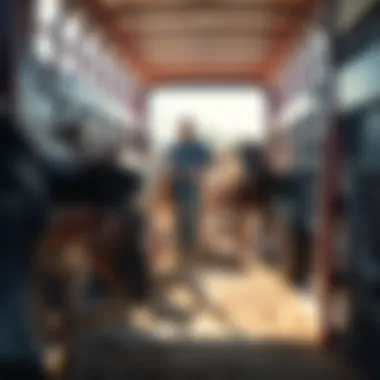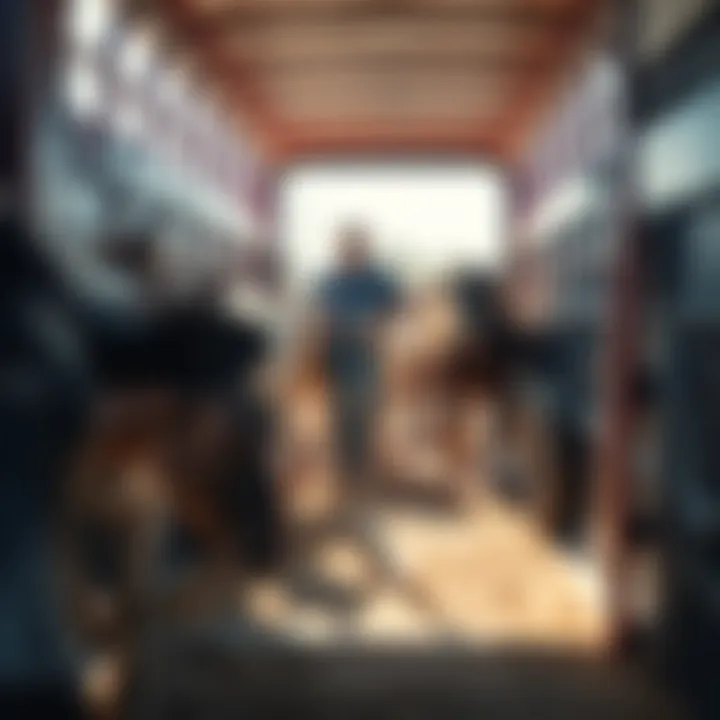Texas Stock Trailers: A Deep Dive into Their Role


Key Insights
Overview of the Topic
In the landscape of Texan agriculture, stock trailers play a pivotal role. They are not just vehicles but essential tools that facilitate the movement of livestock across vast distances. Be it cows, sheep, or horses, these trailers are designed to ensure that animals are transported safely and efficiently. With the unique terrain and climate of Texas, it’s crucial to understand the specific needs and features that a stock trailer must offer.
Historically, the development of livestock trailers has mirrored advancements in agricultural practices. Innovations in design, technology, and materials have all contributed to making stock trailers more reliable and effective. With a multitude of options available, finding the right trailer is paramount depending on the livestock and the nature of the transport.
Importance in Agriculture/Horticulture/Agronomy
The significance of stock trailers extends beyond mere transportation. They serve as a lifeline in the agricultural ecosystem, enabling farmers to transport their livestock to markets, veterinary clinics, and pastures. Opportunities abound when farmers can move animals efficiently. Here are a few points to consider:
- Efficient Transportation: Farmers can respond quickly to market demands or health issues.
- Animal Welfare: Properly designed trailers ensure that livestock are comfortable during transit.
- Legal Compliance: Many jurisdictions have regulations that specify how livestock should be transported, and adhering to these helps maintain both animal welfare standards and the farmer's reputation.
"A good stock trailer is an investment that pays dividends in efficiency and animal care."
Understanding these factors sets the stage for a deeper dive into the different types of stock trailers, their features, and the best practices for maintenance. This knowledge equips farmers and livestock enthusiasts alike with the tools they need to make informed decisions in their agricultural ventures.
Preamble to Texas Stock Trailers
In the heart of Texas, the vast landscape is not just notable for its ranches and rolling hills but also for the critical role that stock trailers play in agricultural operations. Understanding stock trailers is not just about their size or design; it's about grasping their significance in farming life. As we embark on this exploration, we’ll delve into how these vehicles are more than mere utility—they are a lifeline for farmers and ranchers.
Historical Context
The story of stock trailers in Texas is intertwined with the evolution of the livestock industry. Early ranchers relied on rudimentary methods for transporting animals, often using makeshift wooden carts and trucks. These methods were inefficient and could be dangerous for both animals and handlers. However, as the agriculture sector grew, the need for specialized equipment became apparent.
In the mid-20th century, galvanized metal became the go-to material. It offered durability and protection, allowing ranchers to transport livestock safely across long distances. Over the years, the design of stock trailers has evolved, incorporating innovative features that respond to the specialized needs of transporting various types of animals.
Today, stock trailers are often equipped with advanced technology, making them more efficient and safer. But despite modern advancements, the essence of these trailers remains rooted in their history—a commitment to livestock welfare and effective management.
The Importance in Agriculture
Stock trailers represent a critical component in the daily operations of Texas farms and ranches. They facilitate the movement of animals from one location to another, whether it's for feeding, medical care, or sales at market. The importance of these trailers cannot be overstated. Without them, the logistics of managing livestock would be far more complicated, not to mention detrimental to the well-being of the animals.
- Efficiency: A well-designed stock trailer can significantly cut down loading and unloading times, allowing farmers to focus on more pressing tasks.
- Animal Welfare: Trailers built with proper ventilation and space ensure that livestock travel in comfort, reducing stress and injury during transit.
- Financial Impact: By ensuring animals arrive safely at their destination, stock trailers help maximize profits. Well-maintained trailers can reduce veterinary costs and improve profit margins.
Investing in a quality stock trailer pays dividends in the long run, not just in terms of profits, but also in the health and safety of your livestock.
In summary, understanding the nuances of Texas stock trailers is not just beneficial for those in the farming community; it's essential. From appreciating their historical evolution to recognizing their impact on modern agricultural practices, the journey of stock trailers is one of ingenuity, necessity, and unwavering commitment to the land and its creatures.
Types of Stock Trailers
When it comes to transporting livestock, the choice of stock trailer is critical. Each type of trailer has its own set of benefits and drawbacks, and understanding these can greatly assist farmers and transporters in making an informed decision. This section will detail three main types of stock trailers: gooseneck trailers, bumper pull trailers, and livestock semi-trailers. Knowing what each type offers helps ensure that livestock is transported safely and efficiently.
Gooseneck Trailers


Gooseneck trailers are a popular choice among ranchers and farmers. They are designed to provide enhanced stability and better weight distribution during transport. This is made possible by their unique hitching system, which connects to the bed of a pickup truck, allowing the trailer to pivot more smoothly than traditional bumper pull designs.
One major advantage of gooseneck trailers is their larger towing capacity compared to other types. This is particularly beneficial when transporting heavier livestock like cattle or multiple animals at once. Furthermore, many models come equipped with extra features, such as living quarters, which may appeal to show livestock handlers who travel extensively for competitions.
However, it’s crucial to consider the capacity of the towing vehicle, as not all trucks are suitable for pulling heavier gooseneck models. It’s also worth noting that maneuvering in tight spaces can be challenging, particularly if the driver is inexperienced.
Bumper Pull Trailers
Bumper pull trailers, as the name suggests, hitch to the bumper of a vehicle, typically a truck or SUV. These trailers are generally more lightweight and easier to maneuver, making them an ideal choice for smaller operations or individual farmers who may not require a heavy-duty trailer.
One of the enticing factors about bumper pull trailers is their affordability. They tend to be more budget-friendly than gooseneck options, providing a practical entry point for farmers just starting out. Additionally, the simple design allows for easy hook-up and unhooking, which can save time, especially when frequent loading and unloading is needed.
However, bumper pull trailers have some limitations. They often have less cargo space, which may restrict transport if you’re dealing with larger groups of livestock. Furthermore, the towing capacity is lower than that of a gooseneck, meaning they might not be suitable for heavier animals or larger operations.
Livestock Semi-Trailers
Livestock semi-trailers represent the big leagues of livestock transport. Commonly used by larger farms and commercial transporters, these trailers are designed to carry significant amounts of livestock over long distances. Semi-trailers can hold more animals compared to both gooseneck and bumper pull trailers, making them vital for those in the commercial livestock business.
These trailers come in various sizes and configurations, featuring multiple compartments to help manage different species or sizes of livestock. The height and width are often designed to ensure animals have ample room, reducing stress during transport. Additionally, many semi-trailers include advanced ventilation systems, crucial for ensuring animal welfare.
However, operating a livestock semi-trailer requires a special license, as well as a truck capable of towing such a hefty load. This type of trailer can also be more challenging to maneuver in tight spaces and parking lots, making it essential for the driver to possess solid experience and skills.
"Selecting the right stock trailer is crucial for ensuring safe and efficient transportation of livestock. Each type has its own unique features that cater to different needs."
In summary, understanding the characteristics, advantages, and limitations of gooseneck trailers, bumper pull trailers, and livestock semi-trailers is essential for any agricultural operation. The choice of trailer can influence not only the safety and well-being of the livestock but also the efficiency of your hauling practices. Each trailer type has its niche, and knowing where they fit into your operation will guide you in making the best decision.
Key Features of Stock Trailers
Stock trailers play a pivotal role in livestock transportation and agriculture. When selecting a trailer, several features stand out as essential. These features guarantee the safety and well-being of the livestock while ensuring efficiency in transportation. By understanding these key areas, farmers can make informed decisions that meet their operational needs and maintain animal welfare, which is crucial in any agricultural endeavor.
Material Composition
The makeup of a stock trailer significantly affects its durability, weight, and overall performance. Common materials include aluminum, steel, and composite materials.
- Aluminum is often favored for its lightweight and resistance to corrosion. This makes it easier to tow and helps extend the lifespan of the trailer in humid or rainy environments.
- Steel, on the other hand, provides robust strength. However, it’s important to apply protective coatings to prevent rust and other types of wear.
- Composite materials serve as a hybrid option that combines the benefits of metal and plastic, balancing weight and resistance.
When making a choice, consider the local climate and typical load. A well-constructed trailer can handle the rigors of the road and the demands placed on it during use.
Size and Capacity Considerations
Selecting the right size is crucial when it comes to stock trailers. The size impacts how many animals can be transported safely and comfortably. Here are a few aspects to contemplate:
- Length and Width: The dimensions dictate how much space each animal has. This is essential for minimizing stress during transport. It’s critical to adhere to guidelines on animal spacing to allow proper movement.
- Weight Capacity: Always check the weight ratings. Each trailer has a maximum load capacity that should not be exceeded to ensure safety and compliance with transportation regulations.
- Customization Options: Some trailers offer customization to fit specific livestock needs, such as separators for different species. Investing in a trailer that matches your specific requirements can save trouble in the long run.
Ventilation and Safety Features


Proper ventilation is vital for maintaining the health of the livestock during transport. Without adequate airflow, animals can become stressed, leading to dehydration or heat exhaustion. Here’s what to look for:
- Ventilation Openings: Look for trailers that incorporate multiple vents or adjustable openings. This allows fresh air to circulate and provides a way for heat to escape, particularly on hot days.
- Safety Latches and Features: Investing in a trailer with secure latches ensures that animals remain safely inside during transit. Safety features such as non-slip ramps and flooring to prevent animals from slipping help in reducing accidents.
"Choosing the right stock trailer isn't just about convenience; it’s about the well-being of your animals and the efficiency of your farming operations."
Legal Regulations Surrounding Stock Trailers
When it comes to the world of stock trailers, legal regulations play a pivotal role in ensuring safety, compliance, and functionality. Understanding these regulations is essential not just for farmers and livestock haulers but also for ensuring the welfare of the animals being transported. Regulatory compliance mitigates the risks associated with livestock transport and guarantees that the transportation methods align with both state and federal guidelines.
Legal frameworks set the bar for the safety and operational standards that stock trailers must meet. They address various aspects of trailer design, operation, and maintenance, which can ultimately influence a farmer's bottom line. When farmers adhere to these regulations, they reduce the risk of accidents, which could lead to financial losses and harm to animals.
Licensing and Registration Requirements
Navigating the licensing and registration landscape for stock trailers can be as intricate as a spider's web. In Texas, farmers must ensure that their trailers are properly registered with the state. The Texas Department of Motor Vehicles requires owners to submit an application for licensing, which often includes proof of ownership and, in some cases, compliance with safety inspections. Depending on the trailer's size and weight, different classes may apply, resulting in varied fees and regulatory requirements.
-Farmers need to gather necessary documents:
- Title or bill of sale demonstrating ownership
- Proof of insurance coverage
- Any previous registration documentation
- Once the application is submitted, farmers may need to undergo safety inspections before receiving the registration.
By completing these steps, farmers not only comply with the law but also ensure that their stock trailers are roadworthy, which is pivotal in protecting the livestock during transport.
Safety Regulations and Compliance
Safety regulations surrounding stock trailers focus on animal welfare and transportation safety. The U.S. Department of Agriculture has established guidelines aimed at safeguarding livestock during transit. These regulations mandate proper ventilation, adequate space, and suitable flooring.
Key safety measures include:
- Ensuring adequate space for animals to stand and lie down comfortably
- Securing the floor to prevent slips and falls
- Incorporating proper ventilation systems to ensure air circulation
It's important for operators to conduct regular maintenance checks, adhering to safety regulations, which outlines the preventive measures that should be taken to avoid accidents. Non-compliance can result in hefty fines and, worse, worse yet, harm to the animals.
As livestock owners or transporters, taking heed of these regulations isn't just about following the law—it's about promoting ethical treatment and ensuring livestock welfare during their journey. By understanding and implementing these legal frameworks, Texas farmers can navigate the landscape of stock trailer operations with more confidence and security, knowing they're doing right by their animals and their business.
Best Practices in Maintenance
Maintaining Texas stock trailers is more than just a task; it’s a critical aspect to ensure safe transportation of livestock and prolong the lifespan of the vehicles. Proper maintenance practices mean fewer breakdowns and better animal welfare. Every farmer understands that a reliable stock trailer is indispensable in their daily operations. Without a sturdy, well-maintained trailer, transporting livestock can become a daunting challenge, possibly impacting the overall productivity of the farm.
Scheduled Inspections and Upkeep
Regular inspections are a must when it comes to stock trailers. Not only do they help in identifying wear and tear, but they also ensure that your trailer complies with safety regulations. Here are the critical components to focus on:
- Tires: Check for tread wear and proper inflation. Uneven wear can suggest alignment issues or overloading. Keeping tires in good condition increases traction and reduces the risk of blowouts.
- Brakes: Ensure the braking system is functioning properly. Any sign of reduced performance should not be ignored. A functional brake system is vital for the safety of both the driver and the livestock.
- Lights: Ensure all lights are operational. This includes brake lights, turn signals, and reflector visibility. Poor visibility can lead to accidents, especially when traveling at night.
- Flooring: Inspect the flooring for any signs of decay or damage. A strong, non-slip surface is crucial to prevent animals from slipping during transport.
- Structural Integrity: Check the frame and body for any signs of rust or structural compromise. Maintaining a solid structure is essential for safe hauling.
Engaging in routine upkeep means you can often catch minor issues before they escalate into significant problems. Many farmers set a schedule, doing bi-weekly checks as well as watching for any signs of deterioration each time they use their trailer.


Common Repairs and Upgrades
Like any vehicle, stock trailers occasionally require repairs and may benefit from upgrades. To keep your trailer working effectively, consider the following:
- Brake Replacement: Over time, brake pads wear out and may need replacement. When they start making a grinding noise, it’s time for new ones. Investing in high-quality brake components can enhance safety and longevity of the trailer.
- Upgrading Axles: If you regularly find yourself hauling heavier loads, consider upgrading your axle to handle the stress better. A stronger axle increases overall safety and reduces blowout risks.
- Installing a Load-Leveling System: A load-leveling system can be a game changer. It helps distribute weight evenly, contributing to safer and smoother rides.
- Reinforcing the Trailer: Depending on what you primarily transport, reinforcing the trailer walls and floor can make a significant difference in durability and safety.
The bottom line is clear: Proper maintenance ensures you avoid costly repairs down the road, provides a safer experience when hauling livestock, and preserves your trailer’s value.
"An ounce of prevention is worth a pound of cure." In the context of stock trailers, a little timely maintenance goes a long way in ensuring your agricultural operations run smoothly.
Economic Impact of Stock Trailers
The economic impact of stock trailers, especially within Texas, is a topic that resonates deeply with those involved in agriculture. These vehicles aren’t just metal structures on wheels; they embody the lifeblood of ranching and farming operations. By facilitating the transport of livestock, stock trailers play a crucial role that goes beyond mere logistics. Understanding their significance can provide a clearer picture of how they contribute to the success of agricultural enterprises.
Given the dynamic nature of farming, the economic implications of stock trailers deserve thorough examination. Enhancing efficiency in livestock transportation can dramatically affect profit margins and overall productivity. Another layer worth noting is the ripple effect that this sector has on local economies.
Contribution to Local Economies
Stock trailers play an unexpected yet profound role in bolstering local economies across Texas. Farms and ranches that utilize these trailers are often anchored in their communities. Here’s how they contribute:
- Job Creation: Transporting livestock requires manpower not just in the fields but in the logistics sector. Drivers, maintenance crews, and administrative staff secure jobs in the surrounding areas.
- Support for Local Businesses: Farmers frequently rely on local suppliers for equipment, feed, and repairs. The demand generated by stock trailers means steady business for these shops.
- Economic Activity: Moving livestock stimulates various market segments. Whether it's feed suppliers or veterinary services, the impacts are felt throughout the local economy.
- Community Projects: More successful farms can contribute to local initiatives, ranging from schools to health clinics, through direct sponsorship or improved tax revenue.
In summary, stock trailers are more than just tools for transportation; they are vital instruments for economic growth at a community level. They ensure that livestock is moved safely and efficiently, leading to increased sales and better prices for local products.
Cost-Effectiveness for Farmers
When it comes to expenses, stock trailers are often seen as a long-term investment that can offer farmers significant savings. Their cost-effectiveness boils down to several key factors:
- Efficiency in Transportation: A well-designed stock trailer allows farmers to transport more livestock at once, reducing the number of trips needed. This saves on fuel and time.
- Reduced Wear and Tear: With modern trailers engineered for durability, there is less need for frequent replacements or extensive repairs. This aspect helps in cost control—fewer breakdowns mean less downtime.
- Higher Livestock Value: Healthy animals transported effectively tend to maintain higher market values. A good trailer minimizes stress on livestock, ensuring that they arrive in prime condition, which can lead to superior pricing at the market.
- Versatility: Many stock trailers are designed for various uses—be it moving cattle, horses, or other livestock. This versatility means one investment can serve multiple purposes, spreading out costs over different farming needs.
In essence, investing in the right stock trailer can yield significant returns. By combining efficient transportation with the ability to adapt to various needs, these trailers become indispensable tools that enhance the financial viability of farming operations in Texas.
Investing in stock trailers isn't just about rigidity; it's about flexibility that fosters resilience.
By examining both the contribution to local economies and the cost-effectiveness for farmers, we begin to see the intricate tapestry of how these trailers help sustain Texas's agricultural backbone.
Culmination
In tying everything up, the exploration of Texas stock trailers reveals their fundamental role in agricultural practices and the transport of livestock. These trailers are not just mere vehicles; they represent the backbone of a process that is critical for farmers across the state. By understanding the nuances of stock trailers—from their types, features, regulatory framework to maintenance—it becomes clear how integral they are to sustaining productivity and efficiency in farming operations.
Recap of Key Points
First, the historical context of stock trailers highlights traditions rooted deep in farming communities. Their evolution mirrors advancements in agri-tech, reflecting the need for better efficiency and safety. Key types include gooseneck, bumper pull, and livestock semi-trailers, each catering to different transportation needs and livestock capacities.
Key features, such as material quality and safety measures, directly impact not only the transport experience for the livestock but also the overall welfare of the animals during transit. Compliance with legal regulations ensures that livestock is transported safely and responsibly, safeguarding both farmers and animals from potential hazards.
The economic perspective sheds light on the contributions of stock trailers to local economies and the cost-effectiveness they provide to farmers. Investing in a solid stock trailer can yield high returns by minimizing losses and enhancing operational capabilities.
Future Trends in Stock Trailer Design
Looking ahead, the future of stock trailer design is poised for innovation. As technology continously evolves, we can anticipate enhancements like integrated tracking systems for livestock, which could streamline operations and improve welfare. Smart trailers might come equipped with climate control settings to ensure optimal conditions for the transport of sensitive animals.
Furthermore, sustainable materials in trailer production are emerging as a priority, responding to environmental concerns and pushing the agricultural sector towards more eco-friendly practices. The shift towards electric-powered trailers is also on the horizon, promising reduced carbon footprints and operational costs, ultimately supporting farmers in their journey towards sustainability.







